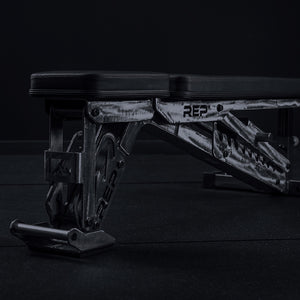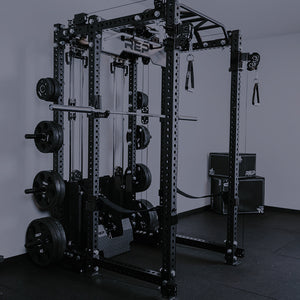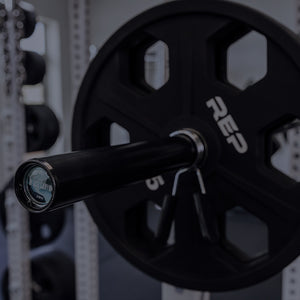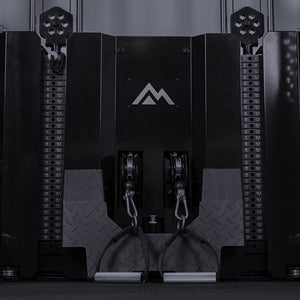
One of the first things to fatigue when lifting a barbell is your grip. Enter: knurling to save the day (or at least the lift).
Knurling is the rough section on the shaft of a barbell. If you look closely, you’ll see it’s a crosshatch pattern that comes in different depths and patterns. It’s a small detail – but it really matters. The purpose: the little grooves increase the friction of your grip and help keep it from slipping out of your hands or off your back in squats.
You’ve probably noticed different barbells feel different in your hands. Some feel sharp and even hurt a little. Some have more knurling sections than others; little marks in the knurling; or no center knurling at all. So, what’s the deal?
Barbell Knurling Depths

A Technique Barbell with shallow knurling.
All knurl is not the same. A basic bar will commonly have shallow or “passive” knurling with finer lines that are closer together. Passive knurling is pretty comfy, and you might not even notice it. That’s why beginners (before callouses consume their palms) often prefer shallower knurl.
Many multi-use bars have a medium knurl – a step above passive. Consider that “all grip, no rip.”
For heavier, grip-intensive lifts like 1RM deadlifts, there’s “aggressive” knurling, which is deeper and feels a bit stabby. Aggressive knurling isn’t exactly comfortable, but it is incredibly helpful.
How the knurling feels is also affected by how the barbell is finished. For example, you can expect to feel the knurl on a bare/stainless-steel bar more than on a Cerakote one.
Barbell Knurling Placement
Knurling is placed where most lifters grip the bar, for example, just outside the center point.

Other bars have special center knurling patches designed to help keep it in position on your back during squats.
You’ll also find knurling toward the outside of the shaft, where you typically grip for bench press or overhead lifts.
When the middle of a bar is smooth, that’s to prevent the bar from scraping your body, like your shins during deadlifts (powerlifters like to wear those adorable, tall socks to further protect their legs).
A smooth center is also nice for high-rep lifts when you don’t want the knurl to repeatedly drag across your body.
Barbell Knurl Marks

You will also see little marks in the knurling sections where there is no knurling. Sort of like smooth rings around the bar. Sometimes there’s one, sometimes two. And they're at different distances along the shaft.
Knurl marks (also called knurl rings or grip markings) help you gauge the distance of your hands on the bar so they’re even.
Strength sports competitions also have standard grip widths to adhere to.
The International Weightlifting Federation’s ring standard is 36” apart (like the Alpine Weightlifting Bar). These knurl marks relate to where you want to put your hands for Oly-style lifts, like the clean and jerk or snatch.
The International Powerlifting Federation’s knurl marks help you line up your hands for the bench press. The standard is 32” apart (like the Double Black Diamond Power Bar).
Because powerlifting exercises tend to require a narrower grip than weightlifting moves, the knurl marks are in different places. A bar with two knurl marks on each side is adhering to both IWF and IPF standards. These are called mixed-used barbells (like the Colorado Bar).
Barbell Knurl Patterns
OK, now if you want to get real nerdy, peep your barbell extra close. You’ll notice there are three common types of knurl patterns: a hill, mountain, and volcano.

The hill is usually passive knurling where the lines are cut into diamonds. Look at the Technique Barbell’s details.

A mountain pattern has tiny peaks cut into the bar that dig into your skin for aggressive knurling, like the Hades Deadlift Bar.

Then volcano is like a combination of the hill and mountain, with diamonds plus peaks. The multi-purpose Colorado Bar has a volcano cut.
What Knurling is Best for Me?

Ultimately, knurling is a preference. Competitive lifters may want to select a barbell with knurl marks that correspond with their sport’s standard. Some people like the aggressive bite of a barbell, whereas others prefer not to annihilate their palms. Pick a barbell that feels good to you and will keep your lifts safe.
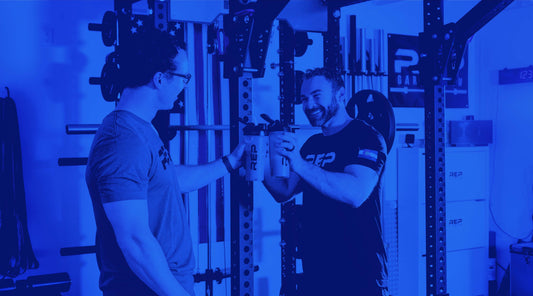
NEWSLETTER SIGNUP
Product launch information, promotions, blogs, and REP news.

